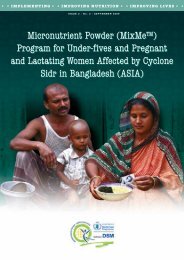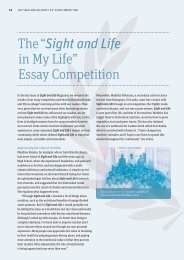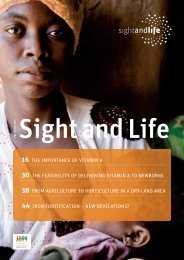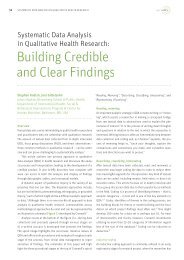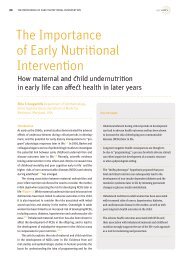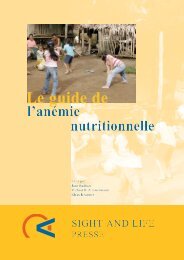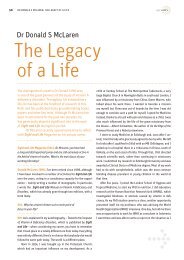16 intrauterine programming of ncd 24 olson memori... - DSM
16 intrauterine programming of ncd 24 olson memori... - DSM
16 intrauterine programming of ncd 24 olson memori... - DSM
- No tags were found...
Create successful ePaper yourself
Turn your PDF publications into a flip-book with our unique Google optimized e-Paper software.
SIGHT AND LIFE | VOL. 25 (2) | 2011 VITAMIN D AND INFLAMMATION 4545matory activity in people who subsequently develop cancer orcardiovascular disease, five or more years before the diseaseis clinically evident. In the British Regional Heart Study, bloodwas taken from 7,735 healthy middle-aged men and there were660 deaths during an average follow-up period <strong>of</strong> 9.2 years.The authors reported that low plasma albumin concentrations(a negative acute phase protein) was the principle factor associatedwith mortality from cardiovascular disease and cancer,even when deaths in the first five years were excluded. 34 Similardata was obtained in the Multiple Risk Factor Intervention Trial,when low albumin was associated with cardiovascular deaths6 –10.5 years after the serum was measured. 35 Similar resultswere also obtained from the National Health and Nutrition ExaminationSurvey Epidemiologic Follow-up Study, although theywere expressed differently. In subjects followed up for a median<strong>of</strong> 15 years, high albumin (>45 g/L) was associated with a lowerrisk <strong>of</strong> death from all causes and CVD.The use <strong>of</strong> albumin versus CRPThese days, the use <strong>of</strong> albumin to indicate inflammation hasbeen replaced by CRP but, nevertheless, all three studies pointto evidence <strong>of</strong> inflammation being present in people who wereapparently healthy at the time the blood was taken, but wedo not know how or whether that inflammation will have influencedplasma 25(OH)D concentrations. However, in a veryrecent study <strong>of</strong> vitamin D and mortality risk in the general population,albumin (positively) and CRP (negatively) were bothcorrelated with plasma 25(OH)D concentrations. 3 In addition,there is another group <strong>of</strong> subjects who displayed evidence <strong>of</strong>mild inflammation as raised CRP concentrations 36,37 and havebeen reported to have poor vitamin D status. 38 Brot and colleagues38 listed a number <strong>of</strong> studies that showed smokers hadpoor vitamin D status and concluded that the effects <strong>of</strong> smokingon vitamin D metabolism was not likely to be explainedby other confounding lifestyle variables. Five hundred and tenhealthy peri-menopausal women, <strong>of</strong> whom 50% were smokers,were found to have similar dietary intakes. If anything, the smokerssunbathed more <strong>of</strong>ten than the non-smokers, but serum25(OH)D levels in the smokers were 10% less than in the nonsmokers.There was a significant negative association betweensmoking and serum concentrations <strong>of</strong> 25(OH)D and 1,25(OH)₂D.Unfortunately, Brot and colleagues did not include indices <strong>of</strong>inflammation in their investigations, but it would be importantto measure both acute and chronic markers <strong>of</strong> inflammation asCRP alone only measures acute inflammation.In fact, a study to examine the possibility that serum 25(OH) Dconcentrations were correlated with CRP or other biomarkers <strong>of</strong>sub-clinical vascular injury was reported by Michos and colleagues.39 The authors were investigating whether serum25(OH) D was causally linked to subclinical vascular disease.Serum CRP levels are associated with cardiovascular risk; therefore,the authors speculated that 25(OH)D and CRP would be correlated.They found no correlation between 25(OH)D and CRP orany other marker <strong>of</strong> vascular disease and concluded that there isno causal relationship between 25(OH)D and CVD risk or, if thereis, it may be mediated through mechanisms other than subclinicalvascular disease severity. However, if low 25(OH)D concentrationsare a product <strong>of</strong> inflammation with a protective functionin the inflammatory cascade, the concentrations <strong>of</strong> 25(OH)D seenin a cross-sectional study will be both a product <strong>of</strong> that clinicalcondition, the pre-sickness concentration <strong>of</strong> 25(OH)D and thelength <strong>of</strong> time being ill. We should not necessarily expect to seeany relationship with markers <strong>of</strong> vascular disease as there aretoo many variables potentially influencing the 25(OH)D concentrationand this will be a general feature <strong>of</strong> many diseases.“If the depression <strong>of</strong> plasma 25(OH)Dis a general response to inflammation,what are the consequencesfor vitamin D status in children?”A final point to consider is that, if the effects on plasma25(OH)D are a general response to inflammation, what are theconsequences for vitamin D status in children? The acute depressionin plasma 25(OH)D did not appear to affect concentrations<strong>of</strong> PTH in the adults, but would this be the same in thegrowing child? The continued depression in plasma 25(OH)Dconcentrations in the Scottish study is also a point <strong>of</strong> concern. Itis important to determine if the depression was due to mobilityand environmental factors directly influencing the patients orto something more insidious associated with the inflammation.These points cannot be answered without further studies.Harmful effects <strong>of</strong> low plasma 25(OH)D concentrationsAlthough I have argued that the fall in plasma 25(OH)D concentrationsassociated with acute inflammation may be a physiologicalresponse by the body to increase “free” plasma 1,25(OH)₂D andbenefit or modulate immune function, it is possible that the concentration<strong>of</strong> 25(OH)D may be too low at the outset to produceany benefit from the response. Plasma 25(OH)D concentrationsin critically ill patients admitted to an intensive care unit in Sydney,Australia were found to be inversely correlated with theirdisease severity as assessed by the Simplified Acute PhysiologyScore (SAPS; high scores indicating severe organ dysfunction).Plasma 25(OH)D and age were the only two independent predictors<strong>of</strong> SAPS (β=-0.59, P



